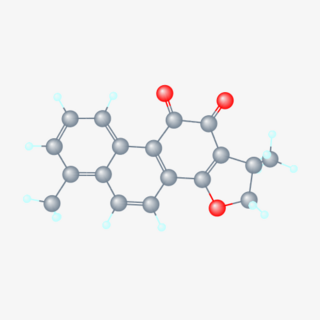
Betacoronavirus pandemicum is a species of virus consisting of many known strains. Two strains of the virus have caused outbreaks of severe respiratory diseases in humans: severe acute respiratory syndrome coronavirus 1, the cause of the 2002–2004 outbreak of severe acute respiratory syndrome (SARS), and severe acute respiratory syndrome coronavirus 2 (SARS-CoV-2), the cause of the pandemic of COVID-19. There are hundreds of other strains of SARSr-CoV, which are only known to infect non-human mammal species: bats are a major reservoir of many strains of SARSr-CoV; several strains have been identified in Himalayan palm civets, which were likely ancestors of SARS-CoV-1.
Protease inhibitors (PIs) are medications that act by interfering with enzymes that cleave proteins. Some of the most well known are antiviral drugs widely used to treat HIV/AIDS, hepatitis C and COVID-19. These protease inhibitors prevent viral replication by selectively binding to viral proteases and blocking proteolytic cleavage of protein precursors that are necessary for the production of infectious viral particles.

Ritonavir, sold under the brand name Norvir, is an antiretroviral medication used along with other medications to treat HIV/AIDS. This combination treatment is known as highly active antiretroviral therapy (HAART). Ritonavir is a protease inhibitor, though it now mainly serves to boost the potency of other protease inhibitors. It may also be used in combination with other medications to treat hepatitis C and COVID-19. It is taken by mouth.

Lopinavir is an antiretroviral of the protease inhibitor class. It is used against HIV infections as a fixed-dose combination with another protease inhibitor, ritonavir (lopinavir/ritonavir).

Emodin (6-methyl-1,3,8-trihydroxyanthraquinone) is an organic compound. Classified as an anthraquinone,it can be isolated from rhubarb, buckthorn, and Japanese knotweed. Emodin is particularly abundant in the roots of the Chinese rhubarb, knotweed and knotgrass as well as Hawaii ‘au‘auko‘i cassia seeds or coffee weed. It is specifically isolated from Rheum palmatum L. It is also produced by many species of fungi, including members of the genera Aspergillus, Pyrenochaeta, and Pestalotiopsis, inter alia. The common name is derived from Rheum emodi, a taxonomic synonym of Rheum australe, and synonyms include emodol, frangula emodin, rheum emodin, 3-methyl-1,6,8-trihydroxyanthraquinone, Schüttgelb (Schuttgelb), and Persian Berry Lake.

Debrisoquine is a derivative of guanidine. It is an antihypertensive drug similar to guanethidine. Debrisoquine is frequently used for phenotyping the CYP2D6 enzyme, a drug-metabolizing enzyme.

Transmembrane protease, serine 2 is an enzyme that in humans is encoded by the TMPRSS2 gene. It belongs to the TMPRSS family of proteins, whose members are transmembrane proteins which have a serine protease activity. The TMPRSS2 protein is found in high concentration in the cell membranes of epithelial cells of the lung and of the prostate, but also in the heart, liver and gastrointestinal tract.

Camostat is a serine protease inhibitor. Serine protease enzymes have a variety of functions in the body, and so camostat has a diverse range of uses. Camostat is approved in Japan for the treatment of chronic pancreatitis and postoperative reflux esophagitis. The oral proteolytic enzyme inhibitor has been on the market since 1985 under the trade name Foipan Tablets. The manufacturer is Ono Pharmaceutical. The drug is used in the treatment of some forms of cancer and is also effective against some viral infections, as well as inhibiting fibrosis in liver or kidney disease or pancreatitis.

The 3C-like protease (3CLpro) or main protease (Mpro), formally known as C30 endopeptidase or 3-chymotrypsin-like protease, is the main protease found in coronaviruses. It cleaves the coronavirus polyprotein at eleven conserved sites. It is a cysteine protease and a member of the PA clan of proteases. It has a cysteine-histidine catalytic dyad at its active site and cleaves a Gln–(Ser/Ala/Gly) peptide bond.

Dihydrotanshinone I (DI) is a naturally occurring compound extracted from Salvia miltiorrhiza Bunge, also known as Chinese sage, red sage root, and the Chinese herbal Dan Shen. It belongs to a class of lipophilic abietane diterpenoids and has been reported to have cytotoxicity to a variety of tumor cells, as well as antiviral effects in vitro. Since they were first discovered, over 40 related compounds and over 50 hydrophilic compounds have been isolated from Dan Shen.

3CLpro-1 is an antiviral drug related to rupintrivir which acts as a 3CL protease inhibitor and was originally developed for the treatment of human enterovirus 71. It is one of the most potent of a large series of compounds developed as inhibitors of the viral enzyme 3CL protease, with an in vitroIC50 of 200 nM. It also shows activity against coronavirus diseases such as SARS and MERS, and is under investigation as a potential treatment agent for the viral disease COVID-19.

GC376 is a broad-spectrum antiviral medication under development by the biopharmaceutical company Anivive Lifesciences for therapeutic uses in humans and animals. Anivive licensed the exclusive worldwide patent rights to GC376 from Kansas State University. As of 2020, GC376 is being investigated as a treatment for COVID-19. GC376 shows activity against many human and animal viruses, including coronavirus and norovirus; the most extensive research has been multiple in vivo studies in cats treating a coronavirus, which causes deadly feline infectious peritonitis. Other research supports use in porcine epidemic diarrhea virus.
Broad-spectrum antivirals (BSAs) are a class of molecules or compounds, which inhibit the infection of multiple viruses from the same or different virus families. BSAs could be divided into experimental and investigational agents, and approved drugs. BSAs work by inhibiting viral proteins or by targeting host cell factors and processes exploited by different viruses during infection. As of 2021, there are 150 known BSAs in varying stages of development, effective against 78 human viruses. BSAs are potential candidates for treatment of emerging and re-emerging viruses, such as ebola, marburg, and SARS-CoV-2. Many BSAs show antiviral activity against other viruses than originally investigated. Efforts in drug repurposing for SARS-CoV-2 is currently underway. A database of BSAs and viruses they inhibit could be found here.

Nirmatrelvir is an antiviral medication developed by Pfizer which acts as an orally active 3C-like protease inhibitor. It is part of a nirmatrelvir/ritonavir combination used to treat COVID-19 and sold under the brand name Paxlovid.

Lufotrelvir (PF-07304814) is an antiviral drug developed by Pfizer which acts as a 3CL protease inhibitor. It is a prodrug with the phosphate group being cleaved in vivo to yield the active agent PF-00835231. Lufotrelvir is in human clinical trials for the treatment of COVID-19, and shows good activity against COVID-19 including several variant strains, but unlike the related drug nirmatrelvir it is not orally active and must be administered by intravenous infusion, and so has been the less favoured candidate for clinical development overall.
In the management of HIV/AIDS, HIV capsid inhibitors are antiretroviral medicines that target the capsid shell of the virus. This is in contrast to most current antiretroviral drugs used to treat HIV, which do not directly target the viral capsid. These have also been termed "Capsid-targeting Antivirals", "Capsid Effectors", and "Capsid Assembly Modulators (CAMs)". Because of this, drugs that specifically inhibit the HIV capsid are being developed in order to reduce the replication of HIV, and treat infections that have become resistant to current antiretroviral therapies.
The COVID Moonshot is a collaborative open-science project started in March 2020 with the goal of developing an un-patented oral antiviral drug to treat SARS-CoV-2, the virus causing COVID-19. COVID Moonshot researchers are targeting the proteins needed to form functioning new viral proteins. They are particularly interested in proteases such as 3C-like protease (Mpro), a coronavirus nonstructural protein that mediates the breaking and replication of proteins.

The nidoviral papain-like protease is a papain-like protease protein domain encoded in the genomes of nidoviruses. It is expressed as part of a large polyprotein from the ORF1a gene and has cysteine protease enzymatic activity responsible for proteolytic cleavage of some of the N-terminal viral nonstructural proteins within the polyprotein. A second protease also encoded by ORF1a, called the 3C-like protease or main protease, is responsible for the majority of further cleavages. Coronaviruses have one or two papain-like protease domains; in SARS-CoV and SARS-CoV-2, one PLPro domain is located in coronavirus nonstructural protein 3 (nsp3). Arteriviruses have two to three PLP domains. In addition to their protease activity, PLP domains function as deubiquitinating enzymes (DUBs) that can cleave the isopeptide bond found in ubiquitin chains. They are also "deISGylating" enzymes that remove the ubiquitin-like domain interferon-stimulated gene 15 (ISG15) from cellular proteins. These activities are likely responsible for antagonizing the activity of the host innate immune system. Because they are essential for viral replication, papain-like protease domains are considered drug targets for the development of antiviral drugs against human pathogens such as MERS-CoV, SARS-CoV, and SARS-CoV-2.

Papain-like proteases are a large protein family of cysteine protease enzymes that share structural and enzymatic properties with the group's namesake member, papain. They are found in all domains of life. In animals, the group is often known as cysteine cathepsins or, in older literature, lysosomal peptidases. In the MEROPS protease enzyme classification system, papain-like proteases form Clan CA. Papain-like proteases share a common catalytic dyad active site featuring a cysteine amino acid residue that acts as a nucleophile.

Jun12682 is an experimental antiviral medication being studied as a potential treatment for COVID-19. It is believed to work by inhibiting SARS-CoV-2 papain-like protease (PLpro), a crucial enzyme for viral replication.
















